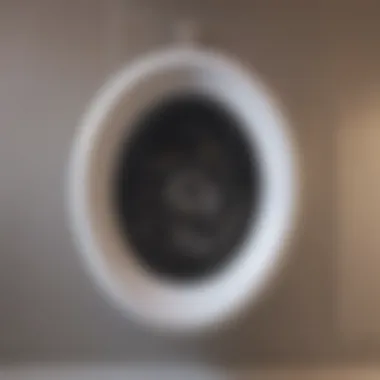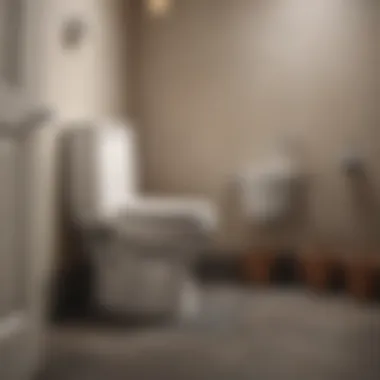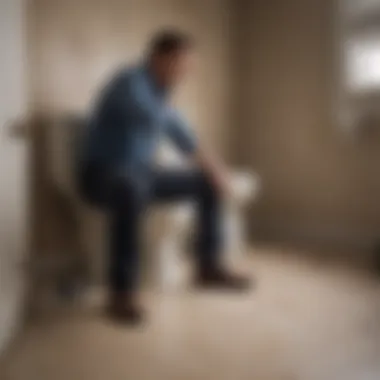Understanding and Resolving Upstairs Toilet Clogs


Intro
Clogs in upstairs toilets can be frustrating for homeowners. Understanding why they occur and how to resolve them is essential. This article will explore the mechanics behind toilets, common clogging issues, and various solutions designed for the average homeowner. Recognizing early indicators and basic troubleshooting techniques can save a lot of trouble in maintaining your plumbing system.
Causes of Upstairs Toilet Clogs
Identifying the causes is crucial for effective prevention. Toilets may clog for several reasons:
- Excessive Flushing of Non-Flushable Items: Many people treat toilets as trash cans, which leads to clogs with wipes, feminine hygiene products, or even paper towels.
- Insufficient Water Flow: Weak flush from old or malfunctioning toilets can cause waste build-up.
- Aging Plumbing: Older pipes may corrode and narrow due to sediment, which can lead to blockages.
Addressing these issues head-on can enhance the lifespan of your toilet and plumbing systems.
Prevention Techniques
Preventing clogs before they occur is more effective than dealing with the issue later. Consider the following strategies:
- Install dual-flush toilets to manage water use while maintaining an effective flush.
- Advise family members on proper toilet usage; emphasize what shouldn’t be flushed.
- Regularly inspect and maintain toilet components, like flappers and fill valves, to assure optimal function.
By taking preemptive action, you can limit future issues and maintain a smoother plumbing experience.
DIY Solutions to Clogged Toilets
When clogs do happen, there are some tried-and-true DIY methods:
- Plunger: Standard, often effective. Ensure a good seal and movement to dislodge blockage.
- Toilet Auger: Useful tool for tougher clogs that a plunger can't remove. Insert it into the toilet and crank to break apart obstructions.
- Vinegar and Baking Soda: A chemical-free method; pour vinegar and baking soda in the toilet. Let it fizz and then flush with hot water later.
Various options may suit different clog types. Try these methods before escalating to professional help but use your judgment about risks and your comfort with plumbing tasks.
When to Call a Professional
It’s essential to know the limits of DIY solutions. When clogs persist or reoccur frequently, there might be significant underlying issues with pipes or sewer lines. Recognizing the signs can direct you to call a plumber promptly.
Consult a plumbing expert if you experience:
- Frequent clogs despite using preventive measures.
- Unpleasant odors lingering, indicating possible ruptured pipes or sewer interruptions.
- Signs of leakage or visible water damage near or in the bathroom.
Proper timing in engaging a plumbing service can help mitigate larger problems that will cost more in repairs down the road.
Understanding Toilet Mechanisms
Grasping basic toilet mechanics enhances troubleshooting abilities. A toilet usually comprises key components like:
- The tank: Stores water used for flushing.
- The flush valve: Controls water flow from the tank to the bowl.
- The trap: Curves water that retains plumbing flow and prevents backflow.
Familiarization with how these elements work will simplify understanding potential malfunctions and their cause.
Finale
Clogging toilets, especially upstairs, is a common annoyance with practical solutions. Problem avoidance through methods discussed may save significant hassle. Understanding toilet mechanics and being informed about DIY fixes are essential skills for current homeowners.
Engagement with your plumbing before serious problems develop will not only enhance your home's functionality but may also maintain property value. Seeking help at the right time preserves the plumbing system's overall health.
Knowing the tools and strategies available to combat clogs can relieve frustrations and enhance your control over home maintenance processes.
Intro to Toilet Clogs
Toilet clogs are a common household problem that many people encounter. Upstairs toilets, in particular, create unique challenges due to their position in plumbing systems. Grasping the fundamentals of what leads to these clogs is crucial for any homeowner. Having a clear understanding not only helps in quickly diagnosing and resolving issues, but it can also save considerable time and money.
Often, toilet clogs lead to inconvenient interruptions in daily life. Such occurrences can escalate into bigger plumbing problems if left unaddressed. Learning about the different factors that contribute to clogs allows homeowners to implement better preventive maintenance strategies. A well-informed individual can manage these issues more effectively, ensuring comfort and functionality in their living environments.
The Significance of Understanding Clogs
Comprehending the dynamics behind toilet clogs permits individuals to appreciate their plumbing systems on a deeper level. The waste removal mechanism in toilets is not intuitive, causing many not to realize their contribution to clogging. Everyday habits like overuse of toilet paper or disposing of foreign objects escalate the risks associated with clogs. Understanding how clogs develop equips homeowners with the knowledge to address them before they become severe.


Why knowledge matters:
- Informed decisions: Knowing the factors that affect clogging allows for timely interventions.
- Prevention: Understanding what not to flush or what a toilet can handle minimizes risk.
- Cost savings: Addressing minor clogs soon can prevent costly repairs later.
Simply put, familiarity with toilet systems benefits everyone involved. It leads to enhanced bathroom experiences and protects one's home investment.
Common Misconceptions about Toilet Issues
An array of misconceptions surround toilet clogs. Clarifying these myths is vital for better engagement with real plumbing issues the upstairs toilets face. The belief that flushing too frequently will cause clogs is one such distorted view. Frequent flushing can be necessary for maintenance and do not indisputably lead to clogs. Conversely, it's often the overlooked habits that truly lead to significant plumbing issues.
Another common myth is that all clogs are immediate. This might not hold true because small clogs can build over time, slowly becoming more severe. Failing to recognize earlier signs may exacerbate the eventual problem.
Debunking myths:
- Not all things are flushable. Many individuals assume random items can be disposed of in the toilet.
- Blockages are not always visible, causing people to ignore severity early.
- Chemical solutions are perceived as the only solution, disregarding effective, less harmful methods.
Disentangling these misconceptions sharpens awareness and positions homeowners to manage toilets effectively.
Why Upstairs Toilets Get Clogged
Toilet clogs, particularly in upstairs bathrooms, are a common issue that homeowners face. Understanding the reason behind these clogs is crucial. When toilets get clogged, they can lead to significant inconveniences and damage if left unresolved. This section aims to dissect the mechanics of toilets, various causes of clogs, and the influence of plumbing designs.
Understanding Toilet Mechanics
To start, it helps to know how a toilet functions. Essentially, when you flush a toilet, the flush valve opens, allowing water from the tank to rush into the bowl. This water helps to push waste and toilet paper through the trap and eventually into the drain.
Any disruptions in this process can result in clogs. One typical issue occurs with the siphoning system. If the water in the bowl is insufficient or the water flow is disrupted, waste will not leave the bowl properly. This directly contributes to blockages. Additionally, the angle and the length of the pipes affect flow rates, making them vital considerations when addressing clogs.
Common Causes of Clogs
For a better grasp of the cause of toilet clogs, we can categorize them into three common contributors:
Excessive Waste and Paper
When we speak of excessive waste and paper, it refers to the accumulation of human waste and toilet paper that surpasses the flow capacity of pipes. This can create a blockage not just in the bowl but further down the plumbing as well. Typically, this happens when a large amount of toilet paper is used or when items that are not meant to be flushed are disposed of in the toilet. This aspect is common in households where there is a greater likelihood of misuse.
Key characteristic: The composition of products deemed flushable, such as thick paper, poses significant risks for clogs. The substantial size of these products can obstruct the flow, creating resistant blockages, which leads to the addition of burden on plumbing.
Advantages: Understanding this aspect encourages users to be mindful of what is disposed of, promoting better practices around toilet usage.
Foreign Objects
Foreign objects cause clogs quite frequently. This category includes items such as toys, sanitary products, or even excessive amounts of wipes that go down the toilet. These objects can obstruct the natural water flow and cause blockages downstream. This manipulation is especially prevalent among children who may find a toilet to be a curious plaything.
Key characteristic: Unlike waste and paper, foreign objects do not degrade over time within the plumbing system, ensuring that they stay lodged, making it more precarious than organic matter.
Disadvantages: Using the toilet as a disposal site for foreign items contributes heavily to finding trouble in systems unfit for complex waste routing.
Drainage Issues
Finally, drainage issues relate to the plumbing infrastructure surrounding the toilet. This may include damaged or inadequately sized pipes, bends and slopes within plumbing systems, or perhaps long distances from the common drainage point. When water can’t enter a drain as intended, backups occur, causing toilets to clog over time.
Key characteristic: Weak or compromised pipes significantly amplify the risks of clogs further, as not only does this impact toilets, but subsequently it alters overall home drainage efficiency.
Advantages: Addressing drainage unncertanties can restore minimal extensive risk areas when properly rectified and maintained.
Impact of Poor Plumbing Design
Lastly, poor plumbing design shapes the performance of upstairs toilets unprecedentedly. Design flaws may extend not only to the layout but also to their specifications, leading to difficulties in drainage and contributing to recurring blockages. Attention to reliable installations remains paramount for sustaining a clog-free experience. Investing in securing competent plumbing solutions initially can save significant hassle and expenses down the line.
How to Diagnose a Clogged Upstairs Toilet
Diagnosing a clogged upstairs toilet is an essential first step in resolving the issue. Understanding the signs and properly utilizing tools can lead to quicker solutions. This section will help homeowners feel more equipped in identifying problems and taking the right steps. Diagnosing accurately can prevent further damage and costly repairs. Knowing when to escalate the situation to a professional is vital.


Identifying Warning Signs
The initial indication of a clog in an upstairs toilet can be quite straightforward. Homeowners should look for common signals, such as slow draining or gurgling noises when flushing. You may notice water levels fluctuating in the bowl or water rising higher than normal. These signs point toward a potential blockage that needs attention. Ignoring these warnings can worsen the issue and lead to more extensive plumbing problems down the road.
Tools for Diagnosis
Plungers
Plungers are a popular choice for diagnosing toilet clogs due to their simplicity. This tool has a robust suction effect and is effective for addressing minor blockages. A notable characteristic of plungers is their accessibility; they are typically found in most households. Their unique feature is the rubber cup at the end that creates a seal over the toilet bowl’s drainage. While plunging can dislodge smaller objects, overusing this method can scatter debris further down the drain, complicating an already present clog.
Augers
Closely related to plungers, augers provide a more powerful option for diagnosing deep toilet clogs. Their strength comes from a flexible coil that can reach obstructive materials lodged within pipes. Augers are often found in more specialized plumbing kits. A beneficial characteristic is their capability to navigate bends in the plumbing system. However, discretion is key; using an auger incorrectly can damage the interior pipes. Their unique feature makes them suitable for tougher cases beyond the plunger's reach, allowing for effective removal of stubborn clogs without shifting waste further down the line.
Inspection Cameras
Inspection cameras offer a modern approach for accurately diagnosing serious clogs and plumbing issues. These devices, equipped with small cameras, can travel through narrow pipe spaces and reveal underlying conditions. Their primary advantage is the clarity they provide in identifying what is causing the obstruction. While they represent a higher investment compared to plungers or augers, the unique feature of visual confirmation offers homeowners significant insight into their plumbing issues. Since some clogs require extensive treatment, knowing the specific cause upfront facilitates more informed decision-making.
Diagnosing a clogged toilet effectively saves time and possibly money in plumbing repairs. Knowing the warning signs and how to use the right tools enables homeowners to address issues promptly.
DIY Solutions for Clogged Toilets
DIY solutions for clogged toilets empower homeowners to take proactive approaches to common plumbing issues. When a toilet upstairs clogs, immediate attention is essential. Handling these problems yourself can save money and prevent further complications. Understanding the tools and methods available creates a sense of control, making it easier to resolve clogs without waiting for professional assistance.
Step-by-Step Unclogging Methods
When addressing a clogged toilet, specific methods can be employed. Let's explore three of the most effective options: using a plunger, employing an auger, and chemical solutions.
Using a Plunger
The plunger is perhaps the most recognized tool for unclogging toilets. This handy device works by creating pressure that helps to dislodge blockages. The main characteristic of a plunger is its rubber suction cup at the end. It is widely acknowledged as a beneficial first step in many toilet clog situations.
Using a plunger is a straightforward solution. Its advantage lies in its simplicity and effectiveness in cases of minor clogs. However, plungers have their limitations. They may not reach deeper blockages, especially if they are caused by foreign objects or significant buildups within the plumbing.
Employing an Auger
Another useful tool is the plumbing auger, commonly known as a snake. Unlike the plunger, an auger can navigate through the pipes to clear stubborn clogs. The flexibility of the auger allows it to reach further into the toilet's plumbing beyond what the usual plunger can achieve. It is an important option for more severe clogs.
Utilizing an auger often leads to the breakdown of the clog, which helps restore proper flow. Therefore, having an auger on hand can be quite beneficial when basic methods fail. One disadvantage, however, is that improper use can potentially damage pipes. Homeowners should learn the right technique before attempting to use this tool.
Chemical Solutions
For those looking for an alternative approach, various chemical solutions exist that can help break down clogs. These products are typically designed to dissolve waste and paper products, making them a popular choice among many homeowners. Their key feature is the chemical active ingredients that target blockages.
Chemical solutions can be convenient and efficient. They save energy and often produce rapid results. Nonetheless, there are drawbacks. Such products may contain harsh chemicals that can harm plumbing or the environment. It is crucial to read the ingredients and instructions before usage to avoid any damage or personal harm.
When to Avoid DIY Solutions
While DIY methods can be effective, there are scenarios where cautious homeowners should think twice. Significant warning signs may signal deeper plumbing issues that may not be easily fixed without calling for professional help. Examples include persistent clogs, foul odors, and gurgling sounds from drains. When any of these signs occur, it could indicate a serious underlying problem, emphasizing the importance of knowing when to involve an expert.
Preventive Maintenance for Toilets
Preventive maintenance is critical for keeping upstream toilets functioning efficiently. A well-maintained toilet significantly reduces the chances of clogs and other plumbing issues. Regular maintenance can save time, money, and stress from surprises that arises from toilet failures. Knowing how to approach it is essential for every homeowner.
A proactive approach involves understanding the fundamentals of toilet systems. Homeowners should be aware that multiple components function together to ensure smooth operation. Maintenance checks can help identify potential problems long before they escalate into bigger complications.
Maintaining proper toilet function includes examining both external and internal components periodically. Folks may forget that putting off maintenance increases the risk of plumbing mishaps. Dedication to preventive measures might pay off in the long run, both from an efficiency standpoint and reduced repair expenses.
Routine Checks and Maintenance
Routine checks should form the backbone of a preventive strategy. Visual inspections alongside regular cleaning can be reliable. Flush the toilet and observe its mechanics, likewhos flushing strength, leaks, or noises. Minor issues might not assume critical attention at first but can lead to bigger trouble with time.
Regular cleaning is also beneficial. Outdated hardcore toilet agitators could cause clogs synced to built-up force and seek microorganisms to clear out smells. Natural cleaning solutions, including baking soda and vinegar, can refresh pipes without harsh chemicals.


- Flush twice daily to maintain flow and prevent blockages.
- Check for water leaks beneath the tank and around the bowl.
- Remove any debris that accumulates near the sewage outlet.
Doing these checks almost seem pointless, but it could create a significant difference over time. Homeowners can delay their replacements by finely experiementing with teal-themed snakes made specially for averting rapid disorders until it's dyas after its apt on zero watts bill registry. Regular evaluations will definitively cover all angles.
Educating Household Members
Communication and education among household members chop down the chances of toilet issues. Each person in the home should recognise what can safely go into the toilet. Limitings habits merely strengthens the overall function of the toilet system.
Organizing a family meeting to devote a few moments going over toilet protocol may prove helpful and create a shared mindfulness regarding plumbing health. Here are guidelines to cover during it:
- Only waste material and toilet paper should be flushed down the toilet. Emphasize to younger family members the importance of not disposing personal items inside.
- Mind the tank with its float mechanism. Teach folks that altering the float position must remain a careful endeavor seen in procedure manuals and somewhere applied for model functions.
- Period errant explanation for excess paper usage in critical situations aligns clear personal duty with shared accountability.
Educated households maintain toilets more effectively.
Individuals can foster a clan habit of respectful toilet use to seamlessly work towards prevention. Power exists in collaboration and shared responsibilities fosters a organized discipline. Overall, cleaning routines and mindful action between everyone uses no size fit one disadvantage inner selves to cause nurturance thrives.
When to Call a Professional
In addressing toilet clogs, it is essential to recognize when to seek professional assistance. While many homeowners are capable of managing minor issues through do-it-yourself methods, certain situations warrant the expertise of a trained plumber. Realizing the correct time to involve a professional can save both time and potentially avoid costly damage to the plumbing system.
The first consideration involves the indicators of serious issues, which can highlight underlying problems in the plumbing. Recognizing these signs can ensure that you do not waste time on futile attempts or inadvertently impede effective repair.
Indicators of Serious Issues
Slow Draining or Gurgling Noises: If you notice water draining slowly from your toilet or hear gurgling noises coming from the bowl or plumbing, this could signify a blockage deeper in your plumbing.
Frequent Clogs: If your toilet remains prone to clogs even after using given first-aid solutions, this pattern may indicate more complex plumbing challenges behind the scenes.
Water Backflow: Instances when water rises from its usual drain after a flush pose a serious concern. This situation often calls for immediate action and professional attention.
Visible Rot or Leak: If there are potential leaks visible around the toilet base or wall, this often suggests water damage, requiring immediate care.
Multiple Fixtures Affecting Each Other: Should your sink, bathtub, or other plumbing fixtures be experiencing slow drains or clogs simultaneously, this hints at a shared drain issue, indicating potential trouble within the larger plumbing system.
Always choose prevention over damage from neglect.
Choosing the Right Plumber
Selecting an experienced and reliable plumber is crucial to ensuring proper resolution to your plumbing issues. Consider the following aspects while making the selection:
Look for Licenses and Insurance: Ensure that any plumber you consider hiring holds appropriate licenses specific to your location and carries insurance to protect both parties in cases of damage or accidents.
Seek Recommendations and Reviews: Utilizing resources such as reddit.com and facebook.com can effectively guide you toward trusted plumbing services. Additionally, personal recommendations expand your options with first-hand accounts.
Get Multiple Quotes: Many reputable plumbers provide free estimates. Gathering multiple quotes helps you gauge the average market price and best diagnose needed tasks for repair.
Confirm a Written Warranty: Upon receiving service completion, always confirm there is work warranty, ensuring peace of mind for a reasonable time after repairs.
By recognizing indicators of serious issues and employing diligence in vetting potential plumbers, often you can avoid severe ramifications and costly repairs.
Culmination
Understandig and resolving clogged upstairs toilets is vital for maintaining both the functionality and hygiene of your home. Awareness of common causes, solutions, and preventive methods is crucial in avoiding disruptions in your daily life. Many homeowners are unware of basic plumbing systems, which can lead to unnecessary frustrations and expenses. The knowledge gained from this article empowers homeowners to take control of similar plumbing issues.
Recap of Key Points
Looking back at what has been learned, several pivotal points emerge. First, toilets in upper levels often face unique challenges, such as differences in gravity impact and pipeline design. Secondly, identifying signs of clogs early helps mitigate damage and restore normal toilet function quickly.
Furthermore, dilgent maintenance practices can lessen the intensity of future issues. Recognizing when it's time to call a professional plumber can provide peace of mind, ensuring that complex problems are handled outside your expertise.
- Key causes include excessive waste, foreign objects, and drainage problems.
- Diagnosing issues thoroughly can save time and effort in the long run.
- Knowing when to attempt repairs and when to utilize professional help can save expenses.
Encouragement for Proactive Management
Promoting proactive management of toilet health will benefit homeowners suburbs and forts. Being aware and taking simple steps can exponentially decrease the liklihood and frequency of clogs. Educational outreach within families about appropriate toilet use can reduce the amount of non-flushable waste from causing trouble.
Signing up for routine plumbing checks may also help find potential issues early. Building a relationship with a skilled local plumber can facilitate smoother transactions when future emergencies arise.
In summary, consider clogs a minor hindrance rather than an insurmountable barrier. Equip yourself with knowledge and confidence to handle minor plumbing disturbances effectively. Your home deserves to function seamlessly, ensuring comfort and cleanliness.



